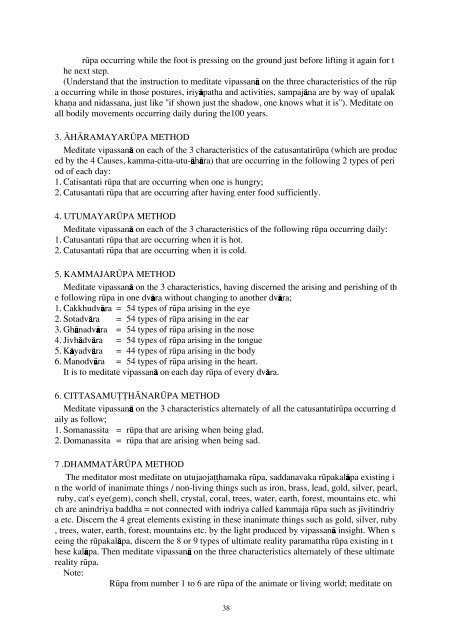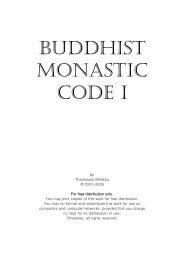Vipassana Kammatthana.pdf
Vipassana Kammatthana.pdf
Vipassana Kammatthana.pdf
Create successful ePaper yourself
Turn your PDF publications into a flip-book with our unique Google optimized e-Paper software.
Ëpa occurring while the foot is pressing on the ground just before lifting it again for t<br />
he next step.<br />
(Understand that the instruction to meditate vipassanå on the three characteristics of the rËp<br />
a occurring while in those postures, iriyåpatha and activities, sampajåna are by way of upalak<br />
khaˆa and nidassana, just like ''if shown just the shadow, one knows what it is''). Meditate on<br />
all bodily movements occurring daily during the100 years.<br />
3. ÓHÓRAMAYARÚPA METHOD<br />
Meditate vipassanå on each of the 3 characteristics of the catusantatirËpa (which are produc<br />
ed by the 4 Causes, kamma-citta-utu-åhåra) that are occurring in the following 2 types of peri<br />
od of each day:<br />
1. Catisantati rËpa that are occurring when one is hungry;<br />
2. Catusantati rËpa that are occurring after having enter food sufficiently.<br />
4. UTUMAYARÚPA METHOD<br />
Meditate vipassanå on each of the 3 characteristics of the following rËpa occurring daily:<br />
1. Catusantati rËpa that are occurring when it is hot.<br />
2. Catusantati rËpa that are occurring when it is cold.<br />
5. KAMMAJARÚPA METHOD<br />
Meditate vipassanå on the 3 characteristics, having discerned the arising and perishing of th<br />
e following rËpa in one dvåra without changing to another dvåra;<br />
1. Cakkhudvåra = 54 types of rËpa arising in the eye<br />
2. Sotadvåra = 54 types of rËpa arising in the ear<br />
3. Ghånadvåra = 54 types of rËpa arising in the nose<br />
4. Jivhådvåra = 54 types of rËpa arising in the tongue<br />
5. Kåyadvåra = 44 types of rËpa arising in the body<br />
6. Manodvåra = 54 types of rËpa arising in the heart.<br />
It is to meditate vipassanå on each day rËpa of every dvåra.<br />
6. CITTASAMUÈÈHÓNARÚPA METHOD<br />
Meditate vipassanå on the 3 characteristics alternately of all the catusantatirËpa occurring d<br />
aily as follow;<br />
1. Somanassita = rËpa that are arising when being glad.<br />
2. Domanassita = rËpa that are arising when being sad.<br />
7 .DHAMMATÓRÚPA METHOD<br />
The meditator most meditate on utujaoja hamaka rËpa, saddanavaka rËpakalåpa existing i<br />
n the world of inanimate things / non-living things such as iron, brass, lead, gold, silver, pearl,<br />
ruby, cat's eye(gem), conch shell, crystal, coral, trees, water, earth, forest, mountains etc. whi<br />
ch are anindriya baddha = not connected with indriya called kammaja rËpa such as j¥vitindriy<br />
a etc. Discern the 4 great elements existing in these inanimate things such as gold, silver, ruby<br />
, trees, water, earth, forest, mountains etc. by the light produced by vipassanå insight. When s<br />
eeing the rËpakalåpa, discern the 8 or 9 types of ultimate reality paramattha rËpa existing in t<br />
hese kalåpa. Then meditate vipassanå on the three characteristics alternately of these ultimate<br />
reality rËpa.<br />
Note:<br />
RËpa from number 1 to 6 are rËpa of the animate or living world; meditate on<br />
38






